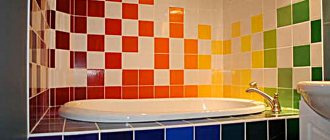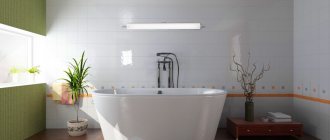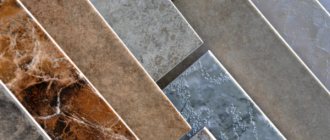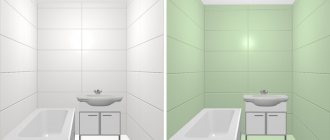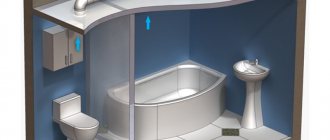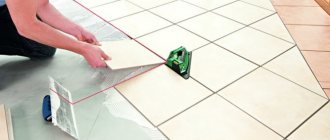Undoubtedly, one of the most popular materials for finishing a bathroom is tile. Moreover, such cladding is applicable for both floors and walls, in some cases even the ceiling. And there are many explanations for its popularity, for example, moisture resistance, ease of maintenance, durability, etc. But today we will not talk about tiles, but about one of the materials that accompany its installation. Namely, the subject of consideration will be the grout for the tiles in the bathroom, and which one is better to choose.
The idea of combining white grout on black tiles
And in fact, this is a very important question, because the appearance of the room after renovation will depend on the choice of grout.
What is grout used for?
A little information for those who have not previously dealt with laying tiles and have no idea what grout is and why it is needed.
Most grout for floor tiles is a dry mixture based on cement or epoxy. This mixture is used diluted in water to fill and protect tile joints.
It is important to understand that grouting is not performed purely for aesthetic reasons, but also directly to protect the coating. In particular, it protects the seams from the penetration of moisture, bacteria and fungus, which has a direct impact on durability.
The disadvantage of white tile grout is that it gets dirty, for this it is better to choose a gray color on which dirt is less visible.
And another important factor is that its use can help hide surface imperfections, in particular:
- Mistakes when laying tiles.
- Uneven walls.
- And a number of other defects that affect the appearance.
We rub the seams with our own hands - instructions
When working, be sure to use rubber gloves, a respirator and safety glasses.
- Depending on the type of grout used, open a bucket of prepared grout or add a liquid component to the dry mixture (hardener for epoxy grout and water or water-based silicone for cement grout). The consistency of the grout should resemble toothpaste.
- Remove crosses and any foreign material from the tile joints.
- Fill the joint spaces with grout. A special rubber spatula is used for this. It is necessary to grout the seams on an area of no more than one square meter at a time. It is better to rub the seams first from top to bottom, and then from left to right - this is how professionals usually work. The more tightly you fill the seams, the stronger the tile will hold.
- Clean any excess grout from the seams. The faster you do this, the easier it will be to remove.
- Gradually move further across the entire area of the room.
Related article: TOP 10 styles for modern bathrooms
As the grout dries, any remaining grout on the tile itself can be wiped off with a rag. Epoxy grout is easier to wash off with warm water and a small concentration of detergent.
Of course, the process of laying tiles is labor-intensive and very troublesome. However, by laying tiles yourself, you have the opportunity to save significantly, because the cost of laying tiles sometimes exceeds the cost of consumables.
You may not succeed in everything smoothly the first time, but you shouldn’t be afraid of difficulties. The main thing is to follow the instructions in everything.
Types of grout
Before you go shopping for grout for your tiles, you need to consider the fact that there are several types of such material. In particular, there are two types:
- Grout based on cement mixture.
- As well as resin-based material (the most popular option is based on epoxy resin.
And let's take a closer look at each of the options.
Cement grout
Cement grout has become the most popular. This is primarily due to its lower cost, and also ease of use.
This mixture is simply diluted with water and can be used immediately. In some cases, grouts are presented in ready-made form; in this situation, they can be found in buckets with an average capacity of 5-7 liters.
It should be noted that it is sometimes more convenient to use a ready-made composition. But do not forget that this is extremely uneconomical. After opening the bucket, such grout will quickly dry out and a large amount of it will have to be thrown away.
Cement grouts are used mainly for working with small joints up to 5 millimeters, and also in some cases with wide ones, more than 5 mm wide. But in the case of wider ones, it is necessary to use a mixture with added sand.
In addition, in this case, the size of the sand grains must be increased in direct proportion to the size of the seam. Also, some formulations contain fungicides (special substances that provide protection against fungus and mold).
The composition of such mixtures is dominated by cement, hardener, dye, and in some mixtures sand and additional chemical components.
Resin based material
Among such materials there are many varieties, so we can distinguish, for example, grout based on furan resin. But the most popular option is considered to be a material based on epoxy resin. While furan compounds have found their use in manufacturing, epoxy mixtures can be found everywhere.
Grout with mother of pearl
When addressing the question of what grout to grout the tiles in the bathroom, most experts consider it their duty to give preference to epoxy grout. This is due to the following factors:
- They are indestructible under the influence of moisture and chemicals, and are also more resistant to contamination.
- They do not require additional processing or components to protect against fungus or mold.
- More durable.
Thus, a cheap option is to choose a cement grout for tiles, which fully performs its functions and will help protect against moisture and various types of fungal damage; in the case of epoxy, the cost increases significantly, but the appearance will of course be different.
But, for covering the floor, cement grout would be a pretty good option.
As we said a little earlier, the most popular composition among resin-based grouts is epoxy. This material is based on epoxy resin, dye and hardener.
You can also note an additional type of more durable grout - cement-latex. But we won’t talk about it, since it is used to decorate the facade of a building (since it has much greater strength than similar ones), and now we are talking about the bathroom.
Tile grout Ceresit
In addition to the main function of filling joints between tiles, stone or other finishing materials, Ceresit grout from a German manufacturer can also improve their appearance. With the right choice of material color, the seams turn out very beautiful and even. And choosing the right grout color is not difficult, because...
the palette includes 31 basic tones and a large number of additional shades. This allows the mixtures to be used for any cladding, mosaic or pattern. It is recommended to use compounds from the same batch to avoid differences in shades after the tile grouting is completed. The price of Ceresit mixtures is quite affordable - on average 60-70 rubles per 1 kg.
The advantage of this brand of grout is that the edges of the tiles are not stained during operation, the remaining mixture is easily washed off from the working surface, and the antifungal additives present in the composition prevent the development of mold. Ceresit grout can be used for joints of any width - from 2 to 15 mm, without forming cracks or scratches in them.
Choosing grout depending on color
An important factor when the question arises is which tile grout to choose for the bathroom.
In the case of cement grout, it can be the color of its main component, i.e. gray, without adding dyes. It can also be any color from the entire palette depending on the design requirements of the room. In addition, by adding special pigments, you can create the desired shade yourself.
At the same time, the range of epoxy grouts is somewhat larger, but you won’t be able to change the shade or color saturation yourself. The only difference, which in some cases is much more attractive, is the use of a shiny effect in such materials. This allows you to create a grout that, after drying, will give the seams the effect of a gold-plated coating, or bronze, metal, or silver.
But no matter what type of grout you choose, there are several rules that must be followed:
- The use of dark or contrasting grout is permissible only when there is 100% confidence in the quality of the installation. This is due to the fact that such shades place emphasis on the design; therefore, even with small errors, they will be clearly highlighted and noticeable, which will ultimately hopelessly spoil the appearance of the room.
- And, accordingly, if there are some defects and errors on the surface, then using lighter colors will help hide them. This way the emphasis will be on the seams, and not on the tile itself.
A little advice! If you do not want to make a mistake when choosing a material, it is advisable to take a sample of the tiles with you to the store when purchasing grout. And also follow our tips on how to choose grout for tiles.
You can calculate the required amount of material to purchase using a tile grout calculator.
Color mixtures
The color of the grout is selected based on the color of the tile.
Cement grout can be either a natural gray color or any other color, from white to black, depending on the color pigment used. If you could not find the required shade of the finished mixture, you can create it yourself by purchasing white grout and a color scheme for it.
The choice of epoxy grout is much wider, but you cannot paint epoxy-based grout yourself. Thanks to the addition of shiny components, manufacturers were able to achieve the effect of gold, silver, bronze, and metallic. The range is truly impressive.
Related article: Design of a one-room Khrushchev apartment
When choosing a grout color, you must follow two simple rules:
- Dark and contrasting grout should only be used if you are sure that the tiles lie perfectly. The fact is that such a contrast of colors emphasizes the pattern of laying the tiles.
- If some errors occurred during laying the tiles, it is better to use a light-colored grout. In this case, the darker color of the tile will visually hide the existing unevenness.
In order not to make a mistake when choosing tiles, we advise you to take samples of the tiles used in the bathroom to a hardware store.
Using clear or colorless grout
In some cases, when tiles of different colors are used in the masonry, or a mosaic is laid, the best answer to the question of which tile grout to choose for the bathtub is to use transparent.
This material is made on the basis of glass, thanks to which it allows you to give the seam a certain transparent, glassy appearance. Although such grout is called transparent only conditionally. It does not transmit light, and accordingly hides the color of the glue in the seams. At the same time, the seam itself takes on the shade of the tile, which allows you to create the effect of an iridescent color scheme.
This material can only be used with seams no larger than 2 millimeters.
Resin based grouts
There is also a fugue based on resin. It is divided into fugue based on epoxy and furan resins. Epoxy grout for tiles is used in those rooms where there is constant contact of the tile surface not only with water, but also with various household chemicals.
Cement compounds cannot cope with what epoxy can cope with, because epoxy fugue is two-component and combines, among other things, a cement base.
In appearance it is practically indistinguishable from cement grout. Also, moisture falling on the surface simply rolls off, while in a cement fugue it is absorbed.
In addition to rooms with high moisture using household chemicals, this type of grout is used for grouting absolutely all types of tiles, as well as natural stone tiles. Sometimes it is used for grouting joints over a heated floor, but this is more likely due to aesthetic parameters.
The advantages of such a fugue include:
- Very long service life.
- Does not fade when exposed to UV rays.
- The temperature withstandable by this composition ranges from -20 to 90 degrees, which makes it very resistant to different climates.
- Resistant to household chemicals and mild acids and alkalis.
We suggest you familiarize yourself with How to remove old grout between tiles (photo, video)
The main disadvantage is the price of such a fugue, as well as the complexity and some problems during dismantling.
In the case of cement fugue, it depends on how the composition itself is diluted. Also, when performing work, special tools and chemicals are used, which also indicates the need for the ability to work with such grout.
We choose only the best
Another question worth raising is which grout is best for bathroom tiles. And to answer it, we will give some of the most popular brands. In particular, we will provide a rating of the TOP 5 leading manufacturers (only based on the opinions of professionals).
- Over many years of work, the Ceresit , and this can be said about all the building materials it produces. The company's product range includes mixtures based on silicone, cement, as well as two-component compositions.
- Second in our ranking is the manufacturer Atlas , which offers epoxy and cement grout.
- Next up is Sopro with cement mixtures.
- Another manufacturer of cement compositions Mapei Ultracolor Plus (Ultracolor Plus)
- And the last to produce two-component epoxy products is Litokol .
But remember, no matter what grout you choose for your bathroom tiles, its high quality is only 20% of success. To obtain a reliable result, you must strictly follow all instructions for its application.
Tile grout Ceresit
When choosing a moisture-resistant sealant for the bathroom, you need to take into account the following parameters:
- Resistant to water.
- Degree of shrinkage.
- Strength indicators.
- Degree of moisture absorption.
When purchasing a waterproof grout sealant, you also need to consider the shade. It must match the color scheme in the interior and the color of the tiles. Today, this should not be a problem, since waterproof grouts are available in a wide range of colors.
Ceresit (Ceresit)
The manufacturer Ceresit (Ceresit) produces waterproof cement-based sealant. The range also includes one-component silicone-based grout and two-component sealant. The cost of production is 260 rubles.
In the photo - grout for bathroom tiles Ceresit
Atlas - the range is rich in mixtures based on cement and epoxy. Its cost is 560 rubles.
Weber Vetonit
Weber Vetonit is a cement-based sealant and costs 450 rubles.
In the photo - grout for tiles in the bathroom Weber Vetonit
The manufacturer Unis produces waterproof cement-based grout. You can buy it for 260 rubles.
In the photo - Unis bathroom tile grout
Litochrome
Litochrome products are cement-based and also have a two-component epoxy grout. You can buy it at a price of 980 rubles.
In the photo - grout for tiles in the bathroom Litochrom
Knauf is the most popular manufacturer today, and its range includes cement-based products. You can purchase it at a price of 520 rubles.
The photo shows Knauf tile grout
Moisture-resistant grout for joints between tiles in the bathroom is a necessary material with which you can obtain high-quality sealing of the joint. You can purchase a mixture based on silicone, cement and epoxy. Each type of product differs in color, composition and consistency.
When choosing grout for Ceresit tiles, you need to consider the following points:
- Purpose. Each room has its own microclimate and humidity. If the mixture is used in damp rooms, then a composition with antifungal components is required to prevent the spread of fungus and mold. It is necessary to consider how often the surface will be exposed to chemicals and cleaning. If the surface is subject to loads and vibrations, the grouting material must have increased elasticity, since a tight, dry joint will quickly crack.
- Connection width. This indicator is written on the packaging. Be sure to take into account the maximum and minimum values when choosing. The manufacturer of ceresit recommends using materials with fillers that impart plasticity when sealing seams up to 3 mm. If the seam is up to 6 mm, then the composition should include sand. For seams up to 20mm, the composition must be of increased elasticity.
- Feature of the tile. Ceresit grout is designed not only for filling the seams between tiles, but also for gluing its end part. Thus, for glossy and decorated tiles, a finely ground composition, polyurethane, is used. When grouting mosaic or glass tiles, an epoxy mixture is suitable. When working with ceramics, you should not use liquid compounds; they will cause difficulties and unnecessary material costs.
- Hue. Affects the appearance of the entire cladding and the room as a whole. Even plain tiles can look original when treated with colored, decorative grout material.
We invite you to familiarize yourself with Walls in the bathroom: popular finishing materials
Scheme of correct grouting of tiles after installation work.
Today, many manufacturers produce grout mixtures. The most widely represented brands are Ceresit and Atlas. The advantages of Ceresit grouts are a wide range of products with different chemical compositions, which allows you to select the most optimal type of grout with the appropriate properties.
Features of Ceresit grout:
- excellent adhesion to the base material and tiles;
- does not change the color of the tiles along the edges;
- many color options;
- CE series grouts are able to withstand the aggressive effects of chemicals;
- have an antifungal effect;
- most materials are frost-resistant and can be used for interior and exterior work;
- A special line of products with increased hydrophobicity has been developed for wet rooms or outdoor use.
Atlas grout is also quite popular among consumers. The products of this company are of excellent quality and meet all technical requirements.
Removing the grout between the tiles is done using a sharp knife.
Features of Atlas grout:
- ease of operation;
- completely fills seams of any width;
- good fit to the edges of the tile even when deformed;
- all fugues include a special additive Myko Bariera, which provides water-repellent, antifungal and antibacterial properties;
- can be used as a grout for tiles in dry and damp rooms;
- seams do not crack;
- the palette contains many shades.
Even the most expensive and beautiful tiles will look terrible if the color of the grout material is chosen incorrectly.
How to choose a color? You need to select the color of the grout material taking into account the room in which the renovation is being done. For the kitchen and bathroom, you should choose a grout that is resistant to moisture. When choosing a color, it is worth considering that when drying, the material brightens by one or two tones. For this reason, you need to choose a mixture that is slightly darker than desired.
If during renovation the task is to give integrity to the pattern or design of the tiles, then you need to choose building materials of the same tone. If the drawing has several tones, then you can use either white color or select a tone for each element of the drawing. For example, white tiles with colored grout sometimes look very good.
How to choose tile grout by color? It is recommended to buy tiles and grout together; to do this, you can take a piece of tile and compare the colors visually. Before using grout in a visible place, it is recommended to test it on a hidden area, for example at the very bottom, in the area that will be behind the furniture.
But you will need to pay due attention to the choice of shade of white. But for floor grouting, it is not recommended to use this color; it is better to take a gray color. You can highlight the tiles by using darker tones of the material or grout of a different color. You should choose a bright mixture only if the design contains other bright elements. If it was used during the renovation multi-colored tiles, then the grouting material must be selected to match the color of the lightest element of the pattern.
When choosing a shade of material to fill the space between tiles, it is important to follow the professional advice listed above, this will help avoid additional costs and disappointment with the result.
Even the most beautiful tiles will not look good if the color of the grout filler is chosen incorrectly. Usually they try to choose a mixture that is as close as possible in tone to the tile, but few know that contrasting colors can be used very effectively; you just need to figure out what color grout to choose and how to combine it with a certain type of tile. It is worth following these recommendations:
- Tiles in the kitchen or bathroom in the form of panels are grouted only with a mixture to match. We must remember that the fugue becomes lighter when it dries, so it is best to choose a solution that is one or two shades darker than the tile.
- Tiles and grout of almost the same tone will give the room integrity and unity. But it can make the design solution boring and monotonous.
- A light fugue looks very impressive with dark tiles, but only when they are in perfect condition. If the tile is frayed or cracked, the contrast will only highlight the imperfections.
Light fugue goes well with dark tiles
The contrast looks especially good with mosaics, but here it is easiest to make a mistake with the choice of shade, so the easiest way is to use a mixture of neutral gray color. For originality, you can make the fugue tone the same as the accessories. It is better to choose grout together with the tile - you can take a piece to the store tile and show it to the consultant.
Buy where they offer a wide range of shades. If possible, you can try spreading the mixture on the tiles and wait until it dries. This will make it easier to decide on a color. For a monochromatic room or a room in the same color scheme, it is better not to choose a contrasting filler for the seam. As a last resort, you can match the color of the furniture if you want to draw attention to it.
Tile grouting process
If the room is tiled with both light and dark tiles, then the filler should be light in a small room (to visually increase the space) and dark in a large room (to reduce the space). Shades of light and dark should match the color scheme of the tile. If it is difficult to choose the shade of grout, then all shades of white will help out. But for the floor, a white tone is impractical, so it is best to choose a mixture of gray, blue or brown, as they say, “the color of dirt” .
When choosing the color scheme for a tiled room, compliance with the overall design concept, as well as individual preferences in the design of the room, is of great importance. In any case, we must strive to ensure that the overall color scheme of the room contributes to good health.
Special grout for porous tiles
Particular attention must be paid to porous tiles, since they have fairly high moisture absorption properties. Experts do not recommend installing it in rooms with high humidity.
But now a solution has been found that allows you to protect the coating from heavy water consumption. To do this, apply a special sealant or varnish. This composition is quite expensive, but at the same time significantly improves the properties of the tile, in particular:
- Improves protection against contamination.
- Makes caring for the coating much easier.
- Helps maintain color throughout the entire period of use.
- Gives a characteristic shine.
To process such tiles, special silicone grouts and sealants are used. The use of such material helps to significantly improve water resistance, and also protects against the occurrence of fungus and mold.
And given that the work is carried out with a special gun, the work process itself becomes not only easy, but also enjoyable.
Tips for choosing grout color
Tinting the grout yourself allows you to create your own original shade.
To do this, dye is added to the white or gray dry mixture. The intensity of the tone is controlled by the amount of dye added to the grout. To obtain a pale shade, about 3 grams of dye per 1 kg of dry mixture is enough. For a rich, bright color, you can add 30 grams of color to 1 kilogram of dry grout.
When renovating your home, it is certainly better to leave all complex tasks in the hands of professionals. But there are also procedures that you can easily handle yourself. This will allow you to save money and establish yourself as a true jack of all trades.
And one of these procedures is the operation of caulking the seams between wall or floor tiles. Today we will talk about how to choose the color of grout for tiles.
Of course, you cannot begin to directly consider suitable options without understanding the main purpose of using grout.
As you know, tiles are used for renovations in the kitchen and bathroom. This material not only has an attractive appearance, in some cases with a claim to luxury, but also has very practical properties:
- Wear resistance;
- Protection against fungus;
- Resistance to humidity;
- Strength;
- Durability.
But, despite such qualities, the tiles have vulnerable spots - the joints where the slab is attached to the floor or wall. These small cracks are capable of accumulating moisture, allowing debris and microbes to pass under the slabs, which inevitably leads to deterioration of the material, its complete shedding or appearance of an ownerless state.
We suggest you familiarize yourself with Connecting a bathtub siphon to the sewer system
Therefore, the question arises about how to choose the right color for grout for tiles. After all, the properties of this material are obvious - it seals the seams between the plates, reliably protecting the product from moisture, mold and mildew.
A very popular trend is the use of white materials for finishing kitchen splashbacks and bathrooms. But when it comes to choosing a grout, a problem arises, because grout of the same color does not look the best against the background of a snow-white slab.
Therefore, in this situation, it is better to make a choice in favor of the following scales:
- Silver-gray;
- Vanilla;
- Jasmine;
- Yellow;
- Mint;
- Jade.
If we talk about the niche of beige products, then they are perhaps most often used for fixing in kitchens. And due to the fact that interesting patterns and designs appear on the tiles, this has long become the standard of choice for most people.
When the tiles are already fixed on the walls or floor, and it comes to choosing a putty, you need to pay attention to the colors of the patterns directly on the product. Grout can be chosen in the same tone as their shades
In addition, the following options are ideal for beige tones:
- Caramel;
- Apricot;
- Hazelnut;
- Ocher;
- Brown;
- Beige (one tone lighter or darker);
- White.
Brown shades for tiles in modern interiors of houses and apartments are also often used, but their scope extends not only to the bathroom and kitchen. Tiles of this shade fit perfectly into the interior of hallways and guest rooms.
The priority factor in choosing a grout for this color shade is the selection of an option that is not too flashy. After all, for the kitchen, choosing a color to match the furniture is an excellent option; for the bathroom, deciding to use putty in the color of the ornament depicted on the tile is an original solution, but for other rooms you need to think more rationally.
Here the grout should be used exclusively for its main practical purpose. Therefore, colors should be chosen from the following list:
- Sienna;
- Brown;
- Light and dark brown;
- Black;
- Graphite;
- Anthracite;
- Cocoa.
By choosing the perfect grout color, you can not only protect the walls and floors of your home, but also give them an even more refined and perfect look.
tile grouts of conventional mixtures
Using a suitable composition, you can not only reliably insulate the cladding seams, but also give the interior of the room a finished look. At the same time, colored grout can become a full-fledged part of the decor.
For example, if you match it to the color of the tile, you can get the effect of a monolithic coating. Or vice versa: by choosing a grout that is contrasting in color and no less bright than the tiles, you can create an original decor that perfectly complements the interior of the room.
To save time when purchasing materials, tiles and grout should be purchased at the same time. If you have already purchased the tiles, you need to have a sample of them with you in the store for comparison and selection of a mixture sealing the joints of a suitable shade.
However, it happens that the owner still does not know which grout to choose for the tiles. There are general recommendations for this, which can be found below:
- Light grout visually unites individual tiles into a coherent pattern, while dark grout divides it into beautiful details.
- If the tile cladding has several colors and a rather complex pattern, the grout should be selected based on the dimensions of the room. In small rooms, its color should match the lightest tile, this will visually enlarge the room. In spacious rooms, you can use tile grout of the darkest color.
- For plain tiles, it is recommended to choose grout based on the colors of the interior elements. In addition, its color should be successfully combined with the floor covering. Usually the grout provides a contrast against its background.
- If the tiles are laid in the form of a multi-colored mosaic, then it is not recommended to make its seams too contrasting and bright. In this case, it is better to use calm shades: beige, light gray and the like.
- It is not recommended to grout the seams of ceramic floor tiles with light-colored mixtures, since after a certain time the cladding may become inexpressive, and its grouting may appear dirty.
- Many dry mixtures change color when prepared, for example, Atlas tile grout. This should be taken into account.
huge amount
In stores, grout colors are presented on cardboards and fans in the form of glued samples. In addition, there are special folding books. You can take out colored sticks from them and apply them to the tiles, choosing the shade of the grout mixture.
If you need any special grout for tiles, then you should pay attention to epoxy mixtures with additives that create certain effects. However, in this case you will have to pay more
The simplest is the mother of pearl effect. This is achieved by adding a packet of pearlescent powder to the grout. After preparing and working out such a mixture, the seams of the tiles will shine better and shimmer in the light like mother-of-pearl. The cost of such an additive is 1300-1700 rubles. for one sachet, which contains 75-150 g of powder. It is enough for 3-5 kg of grout.
In addition to mother-of-pearl, there are additives made from silver or gold chips. In the tile joints they shimmer with bright sparks when the cladding is illuminated. The cost of a package with a golden additive is about 2,500 rubles. They are produced under the brands Litokol and Mapei.
If “gold” is not enough, you can purchase special additives for neutral grout. They give the seams a uniform color of bronze, platinum, gold or silver without shimmer.
For those who love special effects, they produce grout that glows in the dark. For example, the photoluminescent composition Night Vision Litokol can accumulate light during the day and at night emit it in the form of a blue glow for several hours. This pleasure costs 9,500 rubles for 400 g of packaged supplement.
The color palette of Ceresit grout mixtures is very rich and varied. There are 31 primary colors, about 57 additional shades. Such advantages distinguish this brand in the market.
